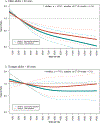Prospective Association of Daily Steps With Cardiovascular Disease: A Harmonized Meta-Analysis
- PMID: 36537288
- PMCID: PMC9839547
- DOI: 10.1161/CIRCULATIONAHA.122.061288
Prospective Association of Daily Steps With Cardiovascular Disease: A Harmonized Meta-Analysis
Abstract
Background: Taking fewer than the widely promoted "10 000 steps per day" has recently been associated with lower risk of all-cause mortality. The relationship of steps and cardiovascular disease (CVD) risk remains poorly described. A meta-analysis examining the dose-response relationship between steps per day and CVD can help inform clinical and public health guidelines.
Methods: Eight prospective studies (20 152 adults [ie, ≥18 years of age]) were included with device-measured steps and participants followed for CVD events. Studies quantified steps per day and CVD events were defined as fatal and nonfatal coronary heart disease, stroke, and heart failure. Cox proportional hazards regression analyses were completed using study-specific quartiles and hazard ratios (HR) and 95% CI were meta-analyzed with inverse-variance-weighted random effects models.
Results: The mean age of participants was 63.2±12.4 years and 52% were women. The mean follow-up was 6.2 years (123 209 person-years), with a total of 1523 CVD events (12.4 per 1000 participant-years) reported. There was a significant difference in the association of steps per day and CVD between older (ie, ≥60 years of age) and younger adults (ie, <60 years of age). For older adults, the HR for quartile 2 was 0.80 (95% CI, 0.69 to 0.93), 0.62 for quartile 3 (95% CI, 0.52 to 0.74), and 0.51 for quartile 4 (95% CI, 0.41 to 0.63) compared with the lowest quartile. For younger adults, the HR for quartile 2 was 0.79 (95% CI, 0.46 to 1.35), 0.90 for quartile 3 (95% CI, 0.64 to 1.25), and 0.95 for quartile 4 (95% CI, 0.61 to 1.48) compared with the lowest quartile. Restricted cubic splines demonstrated a nonlinear association whereby more steps were associated with decreased risk of CVD among older adults.
Conclusions: For older adults, taking more daily steps was associated with a progressively decreased risk of CVD. Monitoring and promoting steps per day is a simple metric for clinician-patient communication and population health to reduce the risk of CVD.
Keywords: cardiovascular disease; exercise; public health; risk reduction behavior.
Conflict of interest statement
CONFLICT OF INTEREST DISCLOSURES
None.
Figures


References
-
- Virani SS, Alonso A, Aparicio HJ, Benjamin EJ, Bittencourt MS, Callaway CW, Carson AP, Chamberlain AM, Cheng S, Delling FN, Elkind MSV, Evenson KR, Ferguson JF, Gupta DK, Khan SS, Kissela BM, Knutson KL, Lee CD, Lewis TT, Liu J, Loop MS, Lutsey PL, Ma J, Mackey J, Martin SS, Matchar DB, Mussolino ME, Navaneethan SD, Perak AM, Roth GA, Samad Z, Satou GM, Schroeder EB, Shah SH, Shay CM, Stokes A, VanWagner LB, Wang NY and Tsao CW. Heart disease and stroke statistics-2021 update: a report from the American Heart Association. Circulation. 2021;143:e254–e743. - PubMed
-
- 2018 Physical Activity Guidelines Advisory Committee. 2018 physical activity guidelines advisory committee scientific report. Washington, DC: U.S. Department of Health and Human Services, 2018.
-
- Arnett DK, Blumenthal RS, Albert MA, Buroker AB, Goldberger ZD, Hahn EJ, Himmelfarb CD, Khera A, Lloyd-Jones D, McEvoy JW, Michos ED, Miedema MD, Muñoz D, Smith SC Jr., Virani SS, Williams KA, Yeboah J and Ziaeian B. 2019 ACC/AHA guideline on the primary prevention of cardiovascular disease: executive summary: a report of the American College of Cardiology/American Heart Association task force on clinical practice guidelines. Circulation. 2019;140:e563–e595. - PMC - PubMed
Publication types
MeSH terms
Grants and funding
- R56 HL125423/HL/NHLBI NIH HHS/United States
- N01 HC095172/HL/NHLBI NIH HHS/United States
- HHSN268201700004C/HB/NHLBI NIH HHS/United States
- P30 DK072476/DK/NIDDK NIH HHS/United States
- U54 GM104940/GM/NIGMS NIH HHS/United States
- HHSN268201800003I/HL/NHLBI NIH HHS/United States
- HHSN268201700001I/HL/NHLBI NIH HHS/United States
- HHSN268201500001I/HL/NHLBI NIH HHS/United States
- 75N92019D00031/HL/NHLBI NIH HHS/United States
- N01 HC095171/HL/NHLBI NIH HHS/United States
- R01 HL078972/HL/NHLBI NIH HHS/United States
- R01 HL131029/HL/NHLBI NIH HHS/United States
- HHSN268201800004I/HL/NHLBI NIH HHS/United States
- HHSN268201500001C/HL/NHLBI NIH HHS/United States
- RG/19/4/34452/BHF_/British Heart Foundation/United Kingdom
- R01 AG047645/AG/NIA NIH HHS/United States
- HHSN268201800007I/HL/NHLBI NIH HHS/United States
- HHSN268201700004I/HL/NHLBI NIH HHS/United States
- N01 HC095170/HL/NHLBI NIH HHS/United States
- R56 AG049886/AG/NIA NIH HHS/United States
- HHSN268201700005C/HL/NHLBI NIH HHS/United States
- HHSN268201700001C/HL/NHLBI NIH HHS/United States
- HHSN268201700002C/HB/NHLBI NIH HHS/United States
- HHSN268201700003C/HL/NHLBI NIH HHS/United States
- HHSN268201700002I/HL/NHLBI NIH HHS/United States
- HHSN268201700005I/HL/NHLBI NIH HHS/United States
- U01 AG022376/AG/NIA NIH HHS/United States
- HHSN268201800005I/HL/NHLBI NIH HHS/United States
- PG/13/86/30546/BHF_/British Heart Foundation/United Kingdom
- HHSN268201700003I/HL/NHLBI NIH HHS/United States
- HHSN268201800006I/HL/NHLBI NIH HHS/United States
LinkOut - more resources
Full Text Sources
Medical

